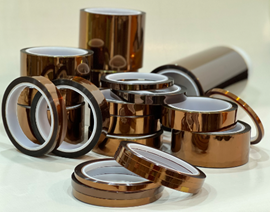Kapton Tape Can Save The Day

[April 2024] Much equipment is not modular, and operators are expected to swap modules to fix many issues. But that is not always the solution. Ron Schacht still calls himself to work on older gear and devise solutions to keep stations on the air. Here is one that might help you one day.
Even though solid-state transmitters have become more and more commonplace every day, there are still a lot of tube transmitters around, especially the higher power varieties.
The problem with some of them is that support from the manufacturers is disappearing—especially when it comes to custom components. Among the items you may find made of unobtainium these days are the Kapton sheets used as screen bypass and the Kapton plate blockers.
Fortunately, you can repair those transmitters with Kapton tape.
KAPTON TAPE
This tape is not terribly expensive; it comes in various widths, thicknesses, and Voltage ratings. It sticks to anything, and in my experience, once it is stuck, it stays. The adhesive is not affected by heat.

I have found that several thicknesses are easily available: 1 mil is rated at 7 kV, 2 mil is rated at 12 kV, and 5 mil is rated at a whopping 19 kV. For some higher-voltage uses, 10 or 20 mil may be found.
PREPARING THE SITE
The main issue with using Kapton tape is using the right rating and ensuring it is installed smoothly.
If you are working with a copper-clad screen bypass sheet that has blown through, use scissors or a razor knife to cut out the area where the arc occurred, including the copper plating. You will want it as smooth as possible without melted copper or Kapton.
Next, peel back the copper on one or both sides of the hole so the copper ends at least ½ inches away from the hole—this way, it will not arc through right at the hole you have cut.
Ensure the chassis in the transmitter where the arc took place is clean and smooth. Use fine emery paper or pot scrubbers to eliminate all the lumps caused by the arc. Remember: arcs breed arcs.
WHICH TAPE TO USE
Now, how much and which tape do you use?
Well, let us assume a 20-kilowatt transmitter, for example, but you can calculate the right version of Kapton for whatever you need.
Consider a typical 20 kW rig. It might run 9000 Volts at 3 Amperes. Calculating with the R=E/I we come out with a plate resistance of 3000 Ohms. Now we go back and calculate E squared = P x R or 20,000 x 3000 = 60,000,000 or E =7746 Volts. Now this is the peak RF Voltage on the plate of the tube to which we add the DC of 9000 Volts = 16,746 Volts. (This is presuming a perfect load on the tube.)
Well, a 5-mil piece would handle it but just barely so I would suggest a 5-mil piece of tape on both sides of the hole to give you at least twice the breakdown. The added thickness might require a little retuning, but it is so slight it would be minimal.
For the screen bypass, one mil usually would be fine as most screen supplies are less than a kilovolt and the RF is minimal, so 2 strips of 1 mil tape is suitable for 14 kV. The slight increase in thickness will not affect the operation as there is still more than enough capacity to keep RF from living on the screen.
The plate blocker is a bit different. If it is in the tube chimney, you will have to unwrap it to find the hole but usually there is no copper plating on the larger plate blockers.
APPLYING THE TAPE
Once you have it all perfectly smooth and clean of any dirt and scrapings, put a piece of Kapton tape over the hole – do it on both sides of the hole.
Again, cut out any lumpy, melted Kapton and clean all metal surfaces to smooth.
With this procedure, I have had very good results and have never had a failure in the same spot – ever.

KAPTON TAPE IS WAY BETTER THAN SLICED BREAD
Another place I have used it Kapton tape with success was in a directional AM with one very high impedance tower and a good deal of power into it.
During some thunderstorms the Delta current transformer would experience arcing from the copper line that passes through the coil to the frame of the Delta coil, and this was the high- power Delta coil.
I wrapped 2 layers of the 5 mil Kapton tape around the copper line where it runs through the coil, extending about 10 inches on both sides of the coil. It has not arced since this treatment about 5 years ago.
PREVENTION
I would suggest you get yourself at least one roll.
In my toolkit, I have a couple of rolls of the 2-inch wide 5 mil stuff.
You can confidently put it anywhere where you might have potential arcing problems.
– – –
Ron Schacht (K3FUT) is a contract engineer in South Dakota. Over the last 60 years he has built some 100 stations, including a dozen with directional antennas. You can connect with Ron at ron.kq1380@nvc.net
– – –
Would you like to know when more articles like this are published? It will take only 30 seconds to
click here and add your name to our secure one-time-a-week Newsletter list.
Your address is never given out to anyone.
– – –
